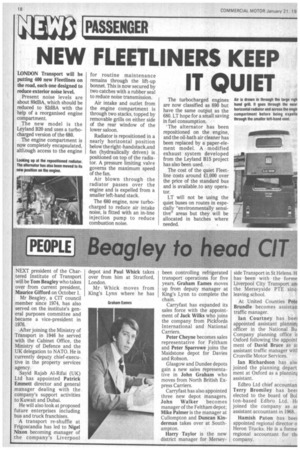LONDON Transport will be putting 400 new Fleetlines on the road, each one designed to reduce exterior noise level.
Page 20

Page 21

If you've noticed an error in this article please click here to report it so we can fix it.
Present noise levels are about 89dBA, which should be reduced to 82dBA with the help of a reorganised engine compartment.
The new model is the Leyland B20 and uses a turbocharged version of the 680.
The engine compartment is now completely encapsulated, although access to the engine for routine maintenance remains through the lift-up bonnet. This is now secured by two catches with a rubber seal to reduce noise transmission.
Air intake and outlet from the engine compartment is through two stacks, topped by removable grills on either side of the rear window of the lower saloon.
Radiator is repositioned in a nearly horizontal position below the right -handstack,and fan (hydraulically driven) is positioned on top of the radiator. A pressure limiting valve governs the maximum speed of the fan.
Air blown through the radiator passes over the engine and is expelled from a smaller left-hand stack.
The 680 engine, now turbocharged to reduce air intake noise, is fitted with an in-line injection pump to reduce combustion noise. The turbocharged engines are now classified as 690 but have the same output as the 680. LT hope for a small saving in fuel consumption.
'The alternator has been repositioned on the engine, and the oil-bath air cleaner has been replaced by a paper-element model. A modified exhaust system developed from the Leyland B15 project has also been used.
The cost of the quiet Fleetline costs around £1,000 over the price of the standard bus and is available.to any operator.
LT will not be using the quiet buses on routes in especially "environmentally sensitive" areas but they will be allocated in batches where needed NEW double-deck bus sign from Metro-Cammell eymann has got off to a ring start with an order for 7e and an option for 50 more om West Midlands Pasnger Transport Executive.
Although no prototype bus is yet been built, M-CW has .omised delivery of the first 'these `Metrobus' vehicles by ugust.
M-CW's formal announceent of its plans now brings re future of its existing interal Metropolitan doubleicker into doubt.
It seems unlikely that letropolitan (with Scania inning-units) would connue to be built alongside the Metrobus which virtually is a separate chassis.
Externally, the new Metrois looks very like the existing letropolitan.
The five buses for West lidlands will have Gardner igines to keep this unit stanird with the majority of the existing fleet.
Gearbox is likely to be a Voith D851 with integral hydraulic retarder, although M-CW is also offering GKN or SCG gearboxes. An alternative engine on offer is the Rolls Royce Eagle diesel. Air suspension similar to the Metropolitan will be fitted. If the Metrobus is successful, over 1000 new jobs will be created over the next few years.
West Midlands PTE has had a look at the new Leyland B15 bus and is also to try a Foden bus. The PTE is dissatisfied with the cost and reliability of its large fleet of Leyland Fleetlines. "For this and other reasons we are supporting the opposition", commented Sir Stan Yapp, leader of the West Midlands Council.


























































































































